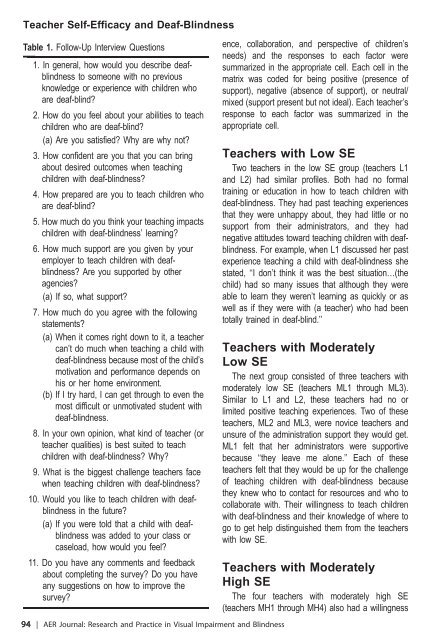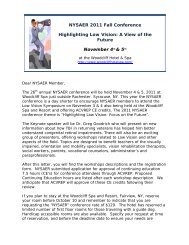Association for Education and Rehabilitation of the ... - AER Online
Association for Education and Rehabilitation of the ... - AER Online
Association for Education and Rehabilitation of the ... - AER Online
You also want an ePaper? Increase the reach of your titles
YUMPU automatically turns print PDFs into web optimized ePapers that Google loves.
Teacher Self-Efficacy <strong>and</strong> Deaf-Blindness<br />
Table 1. Follow-Up Interview Questions<br />
1. In general, how would you describe deafblindness<br />
to someone with no previous<br />
knowledge or experience with children who<br />
are deaf-blind?<br />
2. How do you feel about your abilities to teach<br />
children who are deaf-blind?<br />
(a) Are you satisfied? Why are why not?<br />
3. How confident are you that you can bring<br />
about desired outcomes when teaching<br />
children with deaf-blindness?<br />
4. How prepared are you to teach children who<br />
are deaf-blind?<br />
5. How much do you think your teaching impacts<br />
children with deaf-blindness’ learning?<br />
6. How much support are you given by your<br />
employer to teach children with deafblindness?<br />
Are you supported by o<strong>the</strong>r<br />
agencies?<br />
(a) If so, what support?<br />
7. How much do you agree with <strong>the</strong> following<br />
statements?<br />
(a) When it comes right down to it, a teacher<br />
can’t do much when teaching a child with<br />
deaf-blindness because most <strong>of</strong> <strong>the</strong> child’s<br />
motivation <strong>and</strong> per<strong>for</strong>mance depends on<br />
his or her home environment.<br />
(b) If I try hard, I can get through to even <strong>the</strong><br />
most difficult or unmotivated student with<br />
deaf-blindness.<br />
8. In your own opinion, what kind <strong>of</strong> teacher (or<br />
teacher qualities) is best suited to teach<br />
children with deaf-blindness? Why?<br />
9. What is <strong>the</strong> biggest challenge teachers face<br />
when teaching children with deaf-blindness?<br />
10. Would you like to teach children with deafblindness<br />
in <strong>the</strong> future?<br />
(a) If you were told that a child with deafblindness<br />
was added to your class or<br />
caseload, how would you feel?<br />
11. Do you have any comments <strong>and</strong> feedback<br />
about completing <strong>the</strong> survey? Do you have<br />
any suggestions on how to improve <strong>the</strong><br />
survey?<br />
94 | <strong>AER</strong> Journal: Research <strong>and</strong> Practice in Visual Impairment <strong>and</strong> Blindness<br />
ence, collaboration, <strong>and</strong> perspective <strong>of</strong> children’s<br />
needs) <strong>and</strong> <strong>the</strong> responses to each factor were<br />
summarized in <strong>the</strong> appropriate cell. Each cell in <strong>the</strong><br />
matrix was coded <strong>for</strong> being positive (presence <strong>of</strong><br />
support), negative (absence <strong>of</strong> support), or neutral/<br />
mixed (support present but not ideal). Each teacher’s<br />
response to each factor was summarized in <strong>the</strong><br />
appropriate cell.<br />
Teachers with Low SE<br />
Two teachers in <strong>the</strong> low SE group (teachers L1<br />
<strong>and</strong> L2) had similar pr<strong>of</strong>iles. Both had no <strong>for</strong>mal<br />
training or education in how to teach children with<br />
deaf-blindness. They had past teaching experiences<br />
that <strong>the</strong>y were unhappy about, <strong>the</strong>y had little or no<br />
support from <strong>the</strong>ir administrators, <strong>and</strong> <strong>the</strong>y had<br />
negative attitudes toward teaching children with deafblindness.<br />
For example, when L1 discussed her past<br />
experience teaching a child with deaf-blindness she<br />
stated, ‘‘I don’t think it was <strong>the</strong> best situation…(<strong>the</strong><br />
child) had so many issues that although <strong>the</strong>y were<br />
able to learn <strong>the</strong>y weren’t learning as quickly or as<br />
well as if <strong>the</strong>y were with (a teacher) who had been<br />
totally trained in deaf-blind.’’<br />
Teachers with Moderately<br />
Low SE<br />
The next group consisted <strong>of</strong> three teachers with<br />
moderately low SE (teachers ML1 through ML3).<br />
Similar to L1 <strong>and</strong> L2, <strong>the</strong>se teachers had no or<br />
limited positive teaching experiences. Two <strong>of</strong> <strong>the</strong>se<br />
teachers, ML2 <strong>and</strong> ML3, were novice teachers <strong>and</strong><br />
unsure <strong>of</strong> <strong>the</strong> administration support <strong>the</strong>y would get.<br />
ML1 felt that her administrators were supportive<br />
because ‘‘<strong>the</strong>y leave me alone.’’ Each <strong>of</strong> <strong>the</strong>se<br />
teachers felt that <strong>the</strong>y would be up <strong>for</strong> <strong>the</strong> challenge<br />
<strong>of</strong> teaching children with deaf-blindness because<br />
<strong>the</strong>y knew who to contact <strong>for</strong> resources <strong>and</strong> who to<br />
collaborate with. Their willingness to teach children<br />
with deaf-blindness <strong>and</strong> <strong>the</strong>ir knowledge <strong>of</strong> where to<br />
go to get help distinguished <strong>the</strong>m from <strong>the</strong> teachers<br />
with low SE.<br />
Teachers with Moderately<br />
High SE<br />
The four teachers with moderately high SE<br />
(teachers MH1 through MH4) also had a willingness







